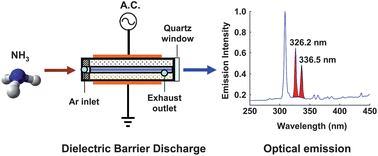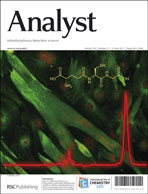Dielectric-barrier discharge (DBD) in argon as a cold source is used for the excitation of gaseous inorganic small molecules at atmospheric pressure. By choosing ammonia as a model molecule, the excitation process and the characteristics of the emission spectra are investigated. The emission spectra are recorded by designing either an open-end or an enclosed DBD excitation/emission source. The enclosed excitation mode effectively eliminates the background emissions arising from the ambient air components, especially those from nitrogen. Two emission lines attributed to the excitation of ammonia, i.e., 326.2 and 336.5 nm, are clearly isolated from the background emission spectra of argon, providing the basis for quantitative analysis. A detection limit of 0.37 ppm is achieved within a linear range of 1.2–35 ppm by monitoring at 326.2 nm. In practice, gaseous samples containing ammonia collected in a public toilet are excited in an enclosed excitation source and the emission at 326.2 nm is monitored for quantitative analysis. An ammonia concentration of 2.4 ppm is derived in the original atmospheric sample, and a spiking recovery of 94.7% is achieved at a 10 ppm ammonia level. This study shows that DBD cold excitation in combination with optical emission spectrometry (OES) offers a promising approach for the detection of ammonia pollution.

You have access to this article
 Please wait while we load your content...
Something went wrong. Try again?
Please wait while we load your content...
Something went wrong. Try again?


 Please wait while we load your content...
Please wait while we load your content...